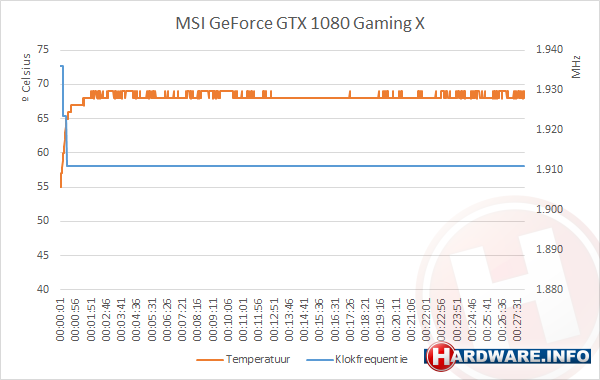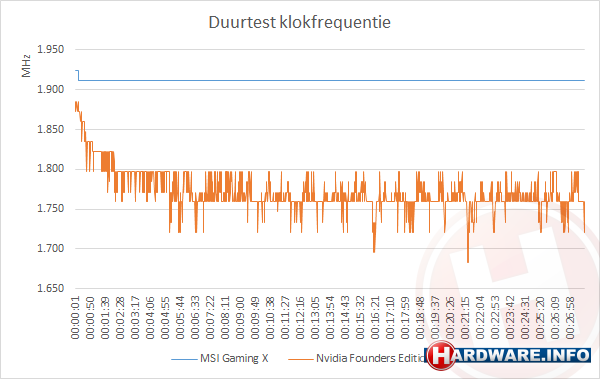king3pj :
I'm just not sure an article about how 970s overclock is all that relevant to the 1070 and 1080. Several 1080 reviews have come out and all of them mention that they are able to achieve overclocks in the 2.0-2.1GHz range. This is true in the founders cards and it's also true in the Gigabyte and MSI reviews I have read.
I don't doubt that all the parts you talk about are better in the more expensive models but if they have the same overclocking limit as the cheaper designs does that really matter? The FE cards won't perform as well because they will hit that thermal throttle point and lower their clock speeds more often but assuming that the cheaper cards' coolers are sufficient they shouldn't run into thermal throttling much, if ever. If they aren't thermal throttling they should theoretically be able to hold the same overclocks as the better models.
Again, all those parts you talk about probably are better but if Nvidia is artificially capping the amount of overclock they can achieve with their limiters I'm not sure why I should pay for them.
1. Past performance is certainly relevant. Was careful to point out the it's not conclusive, but it is certainly worth considering when no definitive info is available. Is it not relevant for example that recent generation AMD cards typically overclock only in single digits while NVidia cards go up and past 30% ?
2. The FE cards are all experiencing thermal throttling so lets not brag to much how well they OC.
3. The 1080s are showing 13 - 19% OCs (from the limited data available) ... considerably **less** than the 25% we saw on the 980 and the 30% we saw on the980 Ti. It is however comparable to the 17% we say on the 970 which, interestingly enough, was artificially nerfed by gimping the throttling point.
The 1070 ... aka the new 980 .. is showing a 25% overclocking ability on the non-reference cards ... interestingly enough exactly matching the OC of the 980.
All that aside... and somewhat off topic. The point being can reference cards match the performance of non-reference cards with superior components ... this is undeniably relevant, because all that has changed is the GPU.....so if we look at the 970 and we see that when AIBs improved these components, we consistently saw a improvement in performance ... if it was true for the 970, why wouldn't it be true for the 980 ... if it's true for the 980, why wouldn't it be true for the 1070 ?
Historically, the reference cards have never been able to match the over clocking ability of the non-reference cards so yes, the relevance is certainly there....
4. I don't know how you missed it, but yes they clearly do not "have the same overclocking limit" the referenced review clearly shows this and the result is consistent across almost every review I have read This was true for the 9xx, 7xx, 6xx, 5xx and so on. It was most glaring with the 5xx series where the 570 cards were well noted for toasting their VRMs, the reference card was well noted for doing this, the EVGA SC was well noted for doing this but again, EVGA rarely changes anything on the PCB for their SC series.
5. Will the 10xx series change all of this ? Too early to tell, a) can't make a judgment as yet as two few samples to choose from b) Overclocking has entered a whole new world with Boost 3.0 the adjustments that are available and c) higher OCs don't always translate into higher fps.
At techpowerup, in BF3....
The 1080 FE managed a 9.1 rating by the reviewer
The 1080 Gaming managed 9.8 rating
I'll be the first to admit .. nVidia is making it harder and harder for its partners to distinguish themselves both legally and with design limitations. The differences between reference and non-reference cards are shrinking such that spending an extra $100 for a Classified, Lightning and Matrix has long not been justifiable. But shrinking is not the same as vanishing.
Non-reference cards still have more too offer. So, to answer your question as to why you should pay more.... let's compare based upon techpowerups analysis of the MSI Gaming 1080 and FE 1080
The 1080 FE managed a 9.1 rating by the reviewer
The 1080 Gaming managed 9.8 rating
The 1080 FE managed a idle sound rating of 28 dbA
The 1080 Gaming managed a idle sound rating of 0 dbA
The 1080 FE managed a idle sound rating of 31 dbA
The 1080 Gaming managed a idle sound rating of 37 dbA
The 1080 FE managed a Load Temp of
83C
The 1080 Gaming managed a Load Temp of 72C
The 1080 FE managed a OC'd Load Temp of
83C
The 1080 Gaming managed a OC'd Load Temp of 74C
There it is ... the big shazul ... the FE card is throttling at stock settings and its temp cant go up when OC'ing as it's already throttling. Why does this matter ?
During gaming, the card goes above 82°C, which results in lower clocks due to Boost 3.0; see our Boost 3.0 Analysis for more details.
Idle temperatures [on the MSI Gaming 4G] are excellent even with the fans turning off in idle. During gaming, the card also runs much cooler than the reference design, which avoids clock throttling above 82°C.
This means that for the first time in GPU history, lower temperatures directly translate into more performance - at any temperature point and not only in the high 80s. I just hope that this will not tempt custom board manufacturers to go for ultra-low temperatures while ignoring fan noise.
That my friend is what I like to call the "crux of the biscuit". Notice the wide gap that ya get along the curve now w/ Boost 3. See links for images
http://www.techpowerup.com/reviews/NVIDIA/GeForce_GTX_1080/images/boost1.jpg
http://tpucdn.com/reviews/NVIDIA/GeForce_GTX_1080/images/boost2_small.jpg
Note how clock frequency doesn't change with heat variations. Now let's look at what happened with the FE card when both cards are subject to a throttling test (most sites don't do this)
The MSI Gaming delivers pool table flat 1910 cock, while the FE is all over the place from 1680 to 1795 .... witht he result being:
It probably wouldn’t be that bad if not the frequency spikes. While average clock is somewhere around officially stated boost clock, those spikes cause micro-stuttering, which negatively affects gaming experience.
Finally ...
The 1080 FE managed 154.9 fps.
The 1080 Gaming managed 159.9 fps.
So is their a difference... yes there certainly is. Overclock the FE all ya want, it's still gonna throttle regardless of what GPU_z calculates what the boost clock **should** be.
And, as expected, the cards are running $20 more than the FE Edition ....
-Would I pay $20 more for the 28 dbA idle / 6 dbA load sound advantage .. in a heartbeat
-Would I pay $20 more for the 9C stock / 11C OC temp advantage .. in a heartbeat
-Would I pay $20 more for a card that doesn't ever throttle .. I'd pay a lot more
Quick look at the 1070 versus MSI Gaming 1070
76C FE load temp drops to 69C w/ MSI Gaming
55C FE VRM temp drops to 40C w/ MSI Gaming
34 dbA idle noise drops to 33 dbA w/ MSI Gaming
40 dbA idle noise drops to 38 dbA w/ MSI Gaming
1975~2050MHz unsteady boost clock jumps to solid 2088 w/ MSI Gaming
The 2088 vs 2050 isn't all that impressive, the steadiness of it is.
I understand your point about cheaper aftermarket cards but that's a big assumption ... are they in fact going to be cheaper ? The 4 cards that generally compete usually come in at the same price (Gigabyte G1 / Asus Strix / MSI Gaming / EVGA SC) ... the SC shouldn't be on that list and should certainly be a cheaper card but historically hasn't been. Ranked by number of newegg reviews, the top 4 970 finishers are ... MSI Gaming 4G 610, Gigabyte G1 499, EVGA SC 472, Asus Strix 458 which indicates, at least to my eyes, that these were the cards that everyone wanted.
Right now, EVGA has two non-reference 1070 cards on newegg ... neither designated as SC. One is $419 (1506 clock), one is $439 (1594 clock).. Is it worth the $2... who knows, you'd have to tear them down and do an analysis and see if the differences pan out. .



